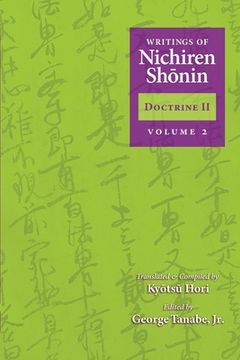Synopsis "Writings of Nichiren Shonin Doctrine 2: Volume 2"
This volume, the 9th project of the English Translation Committee of the Nichiren Shu Overseas Propagation Promotion Association (NOPPA), constitutes all 23 writings of Buddhist reformer Nichiren Shōnin (1222-1282) included in the Nichiren Shōnin Zenshu, Complete Writings of Nichiren Shōnin, Volume 2: Theology 2, published in Tokyo in 1996.The Nichiren Shonin Zenshu is a modern Japanese version of Nichiren's original writings, translated and edited with annotations by modern scholars of Nichiren Buddhism. Despite its all-inclusive title, the Zenshu is highly selective in that it takes into account only writings considered bibliographically authentic: attested to by original manuscripts. Among such texts, those included in the Showa Teihon Nichiren Shonin Ibun, Writings of Nichiren Shonin Standardized in the Showa Period, complied by the Rissho Daigaku Nichiren Kyogaku Kenkyu-jo, Center for the Study of Nichiren Buddhism, published by Minobusan Kuonji Temple between 1951 and 1959, are considered the most authoritative, and they provide the basic texts for this volume.This volume includes two of Nichiren's five major writings, Kaimoku-sho and Kanzin Honzon-sho, both of which were written during his harsh exile to Sado Island. Many others who were seen as a threat to Japan's rulers had been sent there with no provisions for their warmth, nourishment or even safety. In these circumstances Nichiren was determined to provide his followers with a durable preservation of his wisdom, since he was not sure how much longer he would be alive.Nichiren began writing the Kaimoku-sho, Open Your Eyes to the Lotus Teaching, almost immediately on arriving at Sado Island. He starts by covering Buddhism in the context of other teachings which have formed the basis of civilization, including Confucianism and other non-Buddhist teachings. He then argues for the supremacy of the Lotus Sutra among all Buddhist teachings. After surviving the execution at Tatsunokuchi Beach, Nichiren saw himself as the teacher predicted in the Lotus Sutra as the guide sent by the Buddha to lead this world to the True Dharma. His persecutions showed the truth of the predictions of the Lotus Sutra, that those who practiced it would face more troubles than even those the Buddha endured in his lifetime.Most of Nichiren's followers had abandoned him after this second exile, some of them not wanting the same treatment Nichiren endured. He encouraged them to hold strong, that the Buddhas and protective deities would continue to see all of them through these persecutions and that in the end all beings would chant the sacred title, Namu Myoho Renge Kyo, when this world would be transformed into the Pure Land of the Buddha.Soon after finishing the Kaimoku-sho, Nichiren wrote the Kanzin Honzon-sho, A Treatise Revealing the Spiritual Contemplation and the Most Venerable One. This writing is the source of the focus of devotion for all Nichiren Buddhists: the Omandala Gohonzon. Nichiren starts with an explanation of T'ien T'ai's 3000 Existences in One Thought doctrine, the mutual dependence of all worlds, from Hells at the bottom to Buddha realms. He then prescribes the Omandala Gohonzon as a depiction of the ongoing Teaching of the Lotus Sutra, representing not just the sacred title, Namu Myoho Renge Kyo, at the center of the practice, but also the interdependence of all realms as described by T'ien T'ai.

